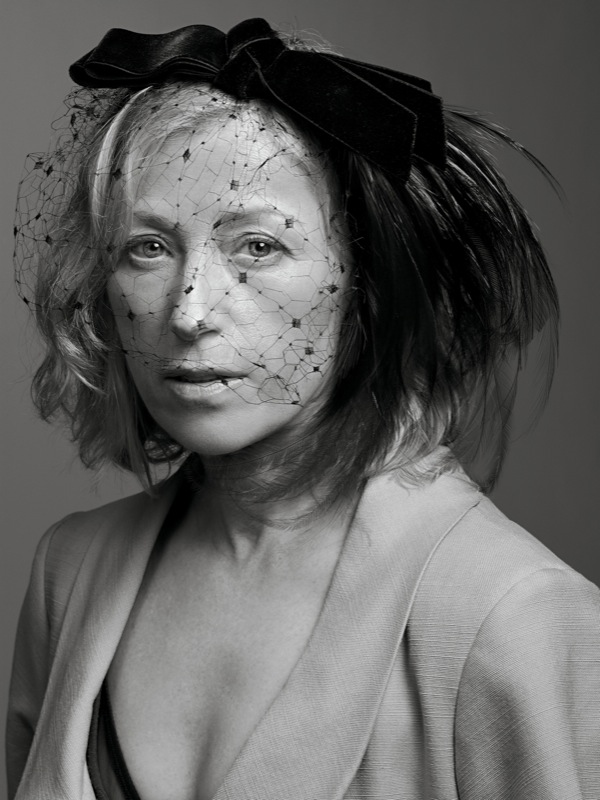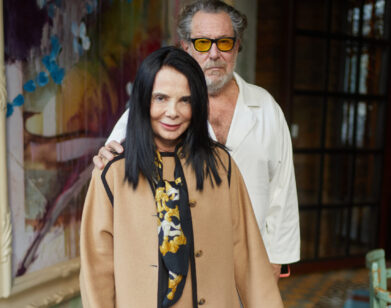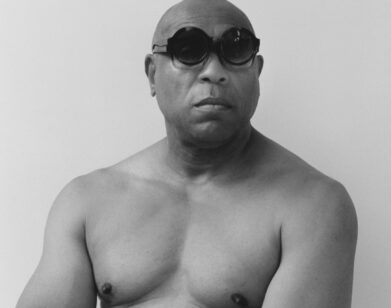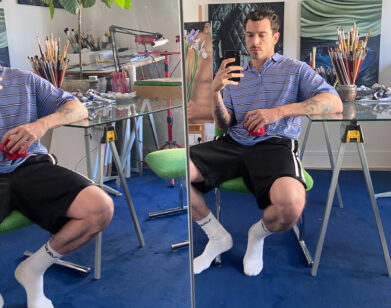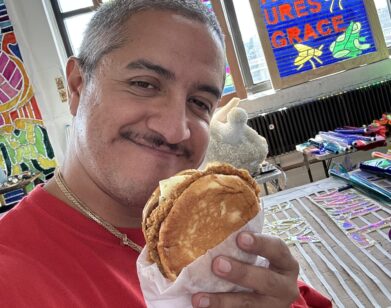Cindy Sherman
Cindy Sherman the ultimate shape-shifter poses for us on the eve of exhibiting a new set of character portraits at New York’s Metro Pictures Gallery. For “20 questions,” friends and colleagues of the artist were invited to pose a question. What follows are Sherman’s responses.
Barbara Kruger: When you were young, did your hopes for how your life might unfold look
anything like how it has actually come to be?
Cindy Sherman: No. The closest I came was thinking that I’d be a street artist or a court illustrator.
Robert Longo: People know you as an extremely accessible, kind, and graceful artist. But what or who really gets you angry, and does any of it play itself out in your artwork?
CS: Inconsiderate, rude behavior drives me nuts. And I guess the inconsiderate rudeness of social ineptitude definitely fuels my work.
Johanna Burton: What keeps you going?
CS: I try to change what I do—if only incrementally—to make me feel like I’m not stagnating.
JB: And what keeps you up at night?
CS: I’m an occasional insomniac, so anything keeps me up.
Peter Schjeldahl: When were you most stuck about what to do next, and what did you do next?
CS: Right after 9/11 I couldn’t see the point in making art. My first attempts were too sad and lifeless. Then I made a couple of Rosie the Riveter-type of portraits: heroic ordinary women, full of optimism.
Isabelle Graw: If we assume that artworks, when circulating on the market, are seen both for their symbolic and their market value, and if we furthermore assume that the price of an artwork is arbitrary and differs from its symbolic importance, how would you describe the intellectual surplus value that your work generates and provides?
CS: I don’t think I can explain it, and I can only take your word that it’s true. I don’t analyze what I’m doing. I’ve read convincing interpretations of my work, and sometimes I’ve noticed something that I wasn’t aware of, but I think, at this point, people read into my work out of habit. Or I’m just very, very smart.
Calvin Tomkins: Which one of the “Untitled Film Stills” comes closest to the real Cindy Sherman?
CS: The “crying” one—Untitled Film Still #27, 1979. Not because I’m a sad person—I’m not—but because in all of the others I’m posed in a self-conscious (though sometimes reflexive) way, and the crying girl has that layer peeled away, showing a vulnerability that I do relate to.
Linda Yablonsky: What word or phrase would you like to see as your epitaph?
CS: “She finally found the perfect outfit.”
Isabelle Huppert: Do you feel strong or weak?
CS: I can be fearlessly strong at times to protect an inner frailty.
Peter Galassi: Has a critic or a curator ever asked you a question that led you to consider your work in a way you hadn’t expected?
CS: Early in my career, a critic said that I needed to “explain” the irony in my work, suggesting that I needed to add text next to the images to help people understand what I was trying to say. At first I was dismayed that I wasn’t making work with a clear enough message. That’s when I realized that that was the exact opposite of what I wanted to do—that I wasn’t responsible for a misinterpretation of my work, that there should be some ambiguity to it. They either got it, or they didn’t.
Margaret Lee: Have you ever taken personal style cues from any of your characters?
CS: When I was shooting the film stills, the clothes I used were my clothes.
Betsy Berne: How would you define success?
CS: Being able to make a living doing something one truly loves to do.
Marvin Heiferman: If for the next year, the only thing you could put up on your wall to look at was a single photographic portrait—of anyone, by anyone—what would you pick and why?
CS: Man Ray’s portrait of Marcel Duchamp as Rrose Sélavy because almost anything by Man Ray would do, but Duchamp is one of my all-time heroes.
Vera Dika: If you could animate one of your photographs and turn it into a movie, which one
would you choose, and why?
CS: A new piece I’ve just done. I refer to her as Jersey Girl. She’s an older woman—although probably my age!—and it looks like she’s shimmying up towards an admirer in a trashy disco. That’s as far as I can see of the movie for now. I think she’s one of the most real characters I’ve ever done. I just see her coming to life.
Klaus Kertess: How do you choose thepersonas you take on in your photographs?
CS: Sometimes just a wig, an item of clothing, or a prop can trigger the character. I also save images of interesting faces from magazines and newspapers and make myself up to look like them-but they usually
turn out nothing like the original.
Laurence Kardish: How do you relate the process of your photographic work to the making of your 1997 film Office Killer?
CS: It’s almost impossible to compare, or perhaps I should say, they’re polar opposites. Before I made Office Killer, I’d never worked with a crew before, nor had I worked with a literal narrative or actors or on such a tight schedule. I’d never even thought about compromise when I worked in my studio. The main similarity is in the visual concept and the result. The major distinction is in the priority of who I ultimately wanted to please: myself or the audience. I wouldn’t want to make another film if I didn’t know exactly what I wanted it to be, and couldn’t be faithful to that vision.
Matthew Higgs: What question would you like to ask yourself?
CS: Why all the shoes?
Arthur C. Danto: Is there some kind of message you hope will come through your work?
CS: For people to not take anything for granted, to respect what they might not understand.
Miranda July: What did you do today?
CS: I ate breakfast, read the paper, answered e-mails, went to the gym, talked to my assistant, ate lunch, made phone calls, met with the electrician, looked at slides, worked on the computer, got ready to go out, saw a performance at the Brooklyn Academy of Music, and went to a party afterward.
Kent Jones: To what extent do you think you are able to see the world through the eyes of others—loved ones and strangers, the well-known and the anonymous, the living and the dead—and with what level of success?
CS: I don’t think I can see the world through other people’s eyes, but I can capture an attitude or a look that makes others think I can. I have an appreciation for why people choose to look the way they do. But I can’t know what they experience.

